Management Accounting and its Role in Organizational Processes
VerifiedAdded on 2023/01/19
|20
|4140
|100
AI Summary
This assignment discusses the concept of management accounting and its importance in organizational processes. It covers different management accounting systems and reports, as well as various cost analysis techniques. The advantages and disadvantages of using planning tools for budget control are also discussed.
Contribute Materials
Your contribution can guide someone’s learning journey. Share your
documents today.
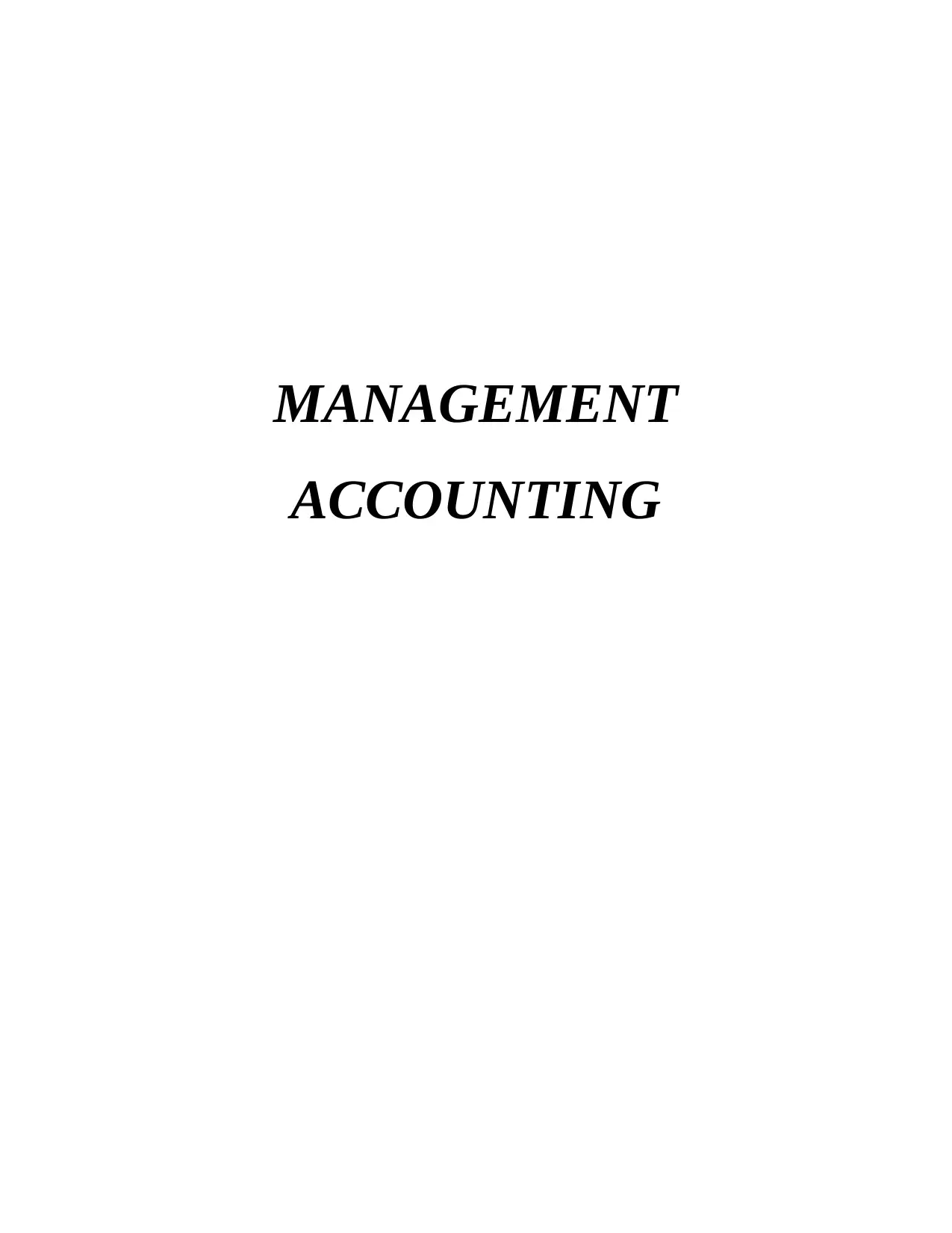
MANAGEMENT
ACCOUNTING
ACCOUNTING
Secure Best Marks with AI Grader
Need help grading? Try our AI Grader for instant feedback on your assignments.
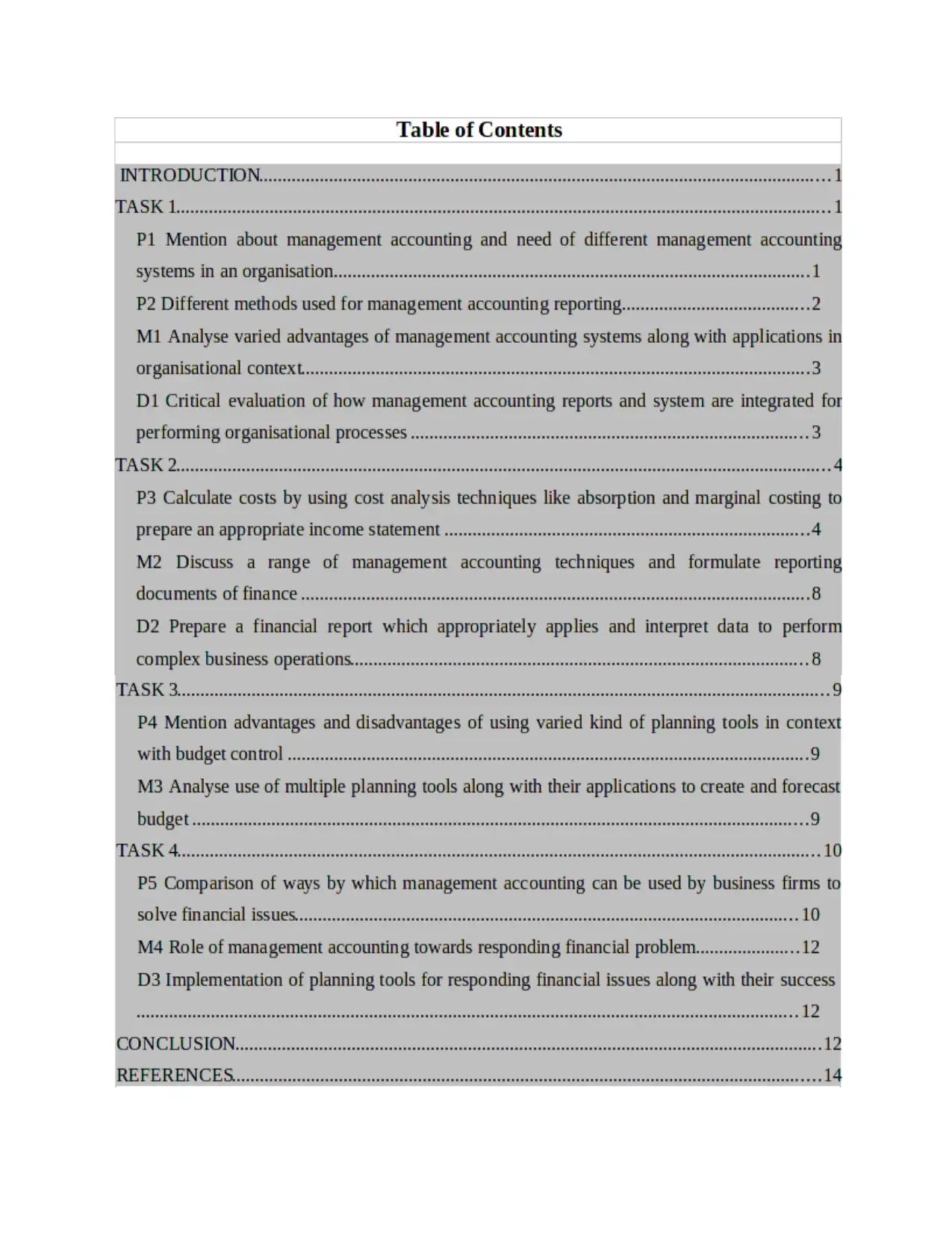

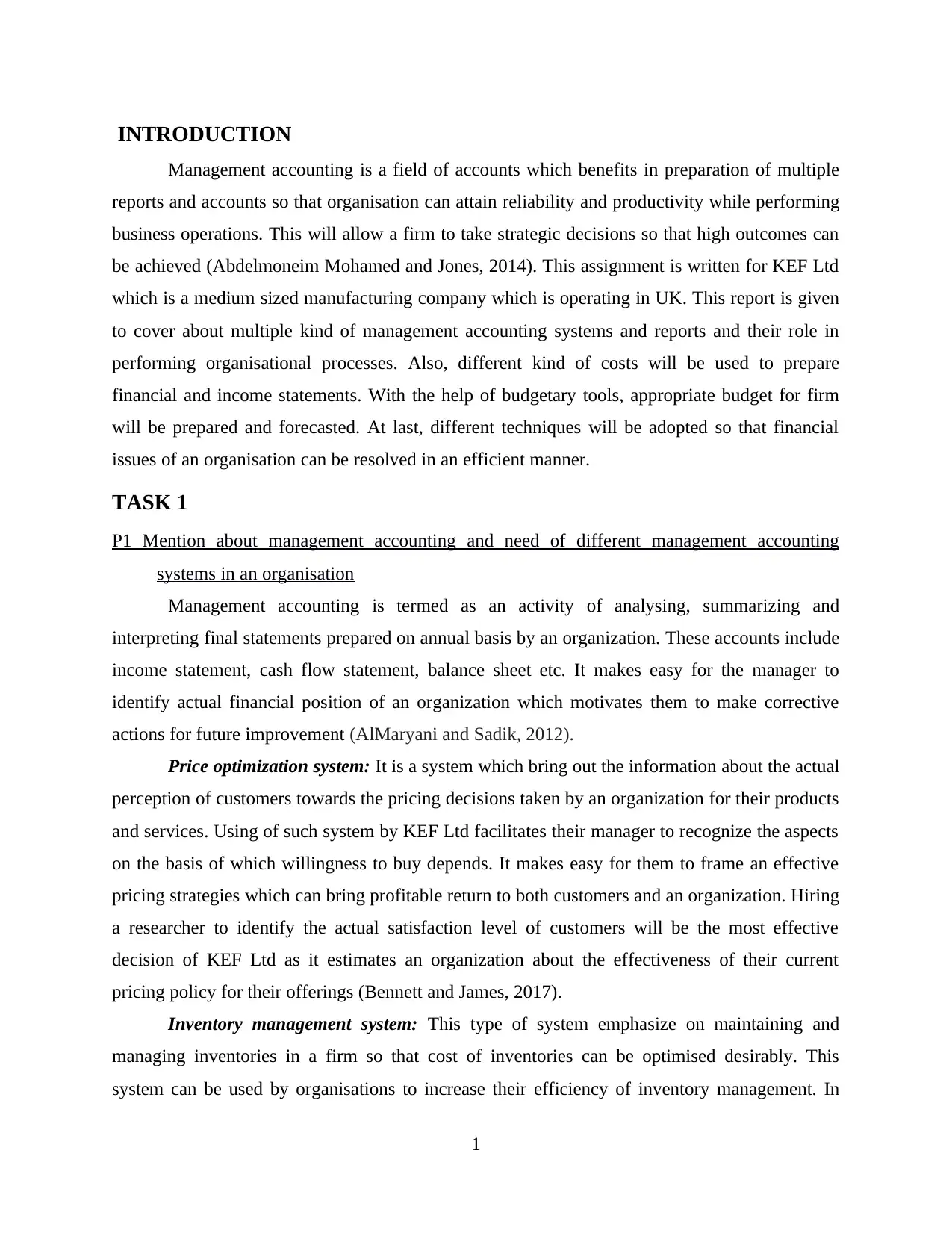
INTRODUCTION
Management accounting is a field of accounts which benefits in preparation of multiple
reports and accounts so that organisation can attain reliability and productivity while performing
business operations. This will allow a firm to take strategic decisions so that high outcomes can
be achieved (Abdelmoneim Mohamed and Jones, 2014). This assignment is written for KEF Ltd
which is a medium sized manufacturing company which is operating in UK. This report is given
to cover about multiple kind of management accounting systems and reports and their role in
performing organisational processes. Also, different kind of costs will be used to prepare
financial and income statements. With the help of budgetary tools, appropriate budget for firm
will be prepared and forecasted. At last, different techniques will be adopted so that financial
issues of an organisation can be resolved in an efficient manner.
TASK 1
P1 Mention about management accounting and need of different management accounting
systems in an organisation
Management accounting is termed as an activity of analysing, summarizing and
interpreting final statements prepared on annual basis by an organization. These accounts include
income statement, cash flow statement, balance sheet etc. It makes easy for the manager to
identify actual financial position of an organization which motivates them to make corrective
actions for future improvement (AlMaryani and Sadik, 2012).
Price optimization system: It is a system which bring out the information about the actual
perception of customers towards the pricing decisions taken by an organization for their products
and services. Using of such system by KEF Ltd facilitates their manager to recognize the aspects
on the basis of which willingness to buy depends. It makes easy for them to frame an effective
pricing strategies which can bring profitable return to both customers and an organization. Hiring
a researcher to identify the actual satisfaction level of customers will be the most effective
decision of KEF Ltd as it estimates an organization about the effectiveness of their current
pricing policy for their offerings (Bennett and James, 2017).
Inventory management system: This type of system emphasize on maintaining and
managing inventories in a firm so that cost of inventories can be optimised desirably. This
system can be used by organisations to increase their efficiency of inventory management. In
1
Management accounting is a field of accounts which benefits in preparation of multiple
reports and accounts so that organisation can attain reliability and productivity while performing
business operations. This will allow a firm to take strategic decisions so that high outcomes can
be achieved (Abdelmoneim Mohamed and Jones, 2014). This assignment is written for KEF Ltd
which is a medium sized manufacturing company which is operating in UK. This report is given
to cover about multiple kind of management accounting systems and reports and their role in
performing organisational processes. Also, different kind of costs will be used to prepare
financial and income statements. With the help of budgetary tools, appropriate budget for firm
will be prepared and forecasted. At last, different techniques will be adopted so that financial
issues of an organisation can be resolved in an efficient manner.
TASK 1
P1 Mention about management accounting and need of different management accounting
systems in an organisation
Management accounting is termed as an activity of analysing, summarizing and
interpreting final statements prepared on annual basis by an organization. These accounts include
income statement, cash flow statement, balance sheet etc. It makes easy for the manager to
identify actual financial position of an organization which motivates them to make corrective
actions for future improvement (AlMaryani and Sadik, 2012).
Price optimization system: It is a system which bring out the information about the actual
perception of customers towards the pricing decisions taken by an organization for their products
and services. Using of such system by KEF Ltd facilitates their manager to recognize the aspects
on the basis of which willingness to buy depends. It makes easy for them to frame an effective
pricing strategies which can bring profitable return to both customers and an organization. Hiring
a researcher to identify the actual satisfaction level of customers will be the most effective
decision of KEF Ltd as it estimates an organization about the effectiveness of their current
pricing policy for their offerings (Bennett and James, 2017).
Inventory management system: This type of system emphasize on maintaining and
managing inventories in a firm so that cost of inventories can be optimised desirably. This
system can be used by organisations to increase their efficiency of inventory management. In
1
Secure Best Marks with AI Grader
Need help grading? Try our AI Grader for instant feedback on your assignments.
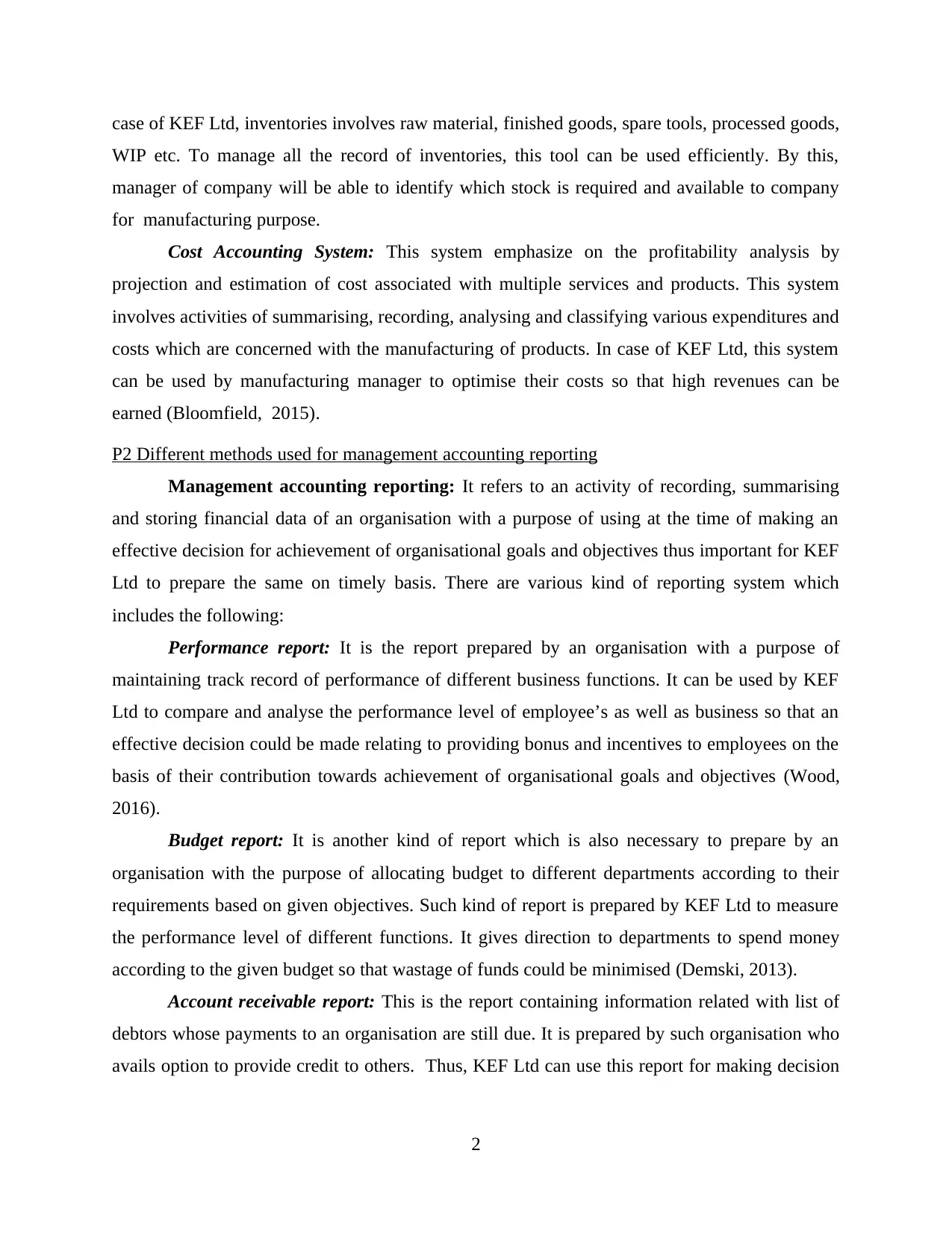
case of KEF Ltd, inventories involves raw material, finished goods, spare tools, processed goods,
WIP etc. To manage all the record of inventories, this tool can be used efficiently. By this,
manager of company will be able to identify which stock is required and available to company
for manufacturing purpose.
Cost Accounting System: This system emphasize on the profitability analysis by
projection and estimation of cost associated with multiple services and products. This system
involves activities of summarising, recording, analysing and classifying various expenditures and
costs which are concerned with the manufacturing of products. In case of KEF Ltd, this system
can be used by manufacturing manager to optimise their costs so that high revenues can be
earned (Bloomfield, 2015).
P2 Different methods used for management accounting reporting
Management accounting reporting: It refers to an activity of recording, summarising
and storing financial data of an organisation with a purpose of using at the time of making an
effective decision for achievement of organisational goals and objectives thus important for KEF
Ltd to prepare the same on timely basis. There are various kind of reporting system which
includes the following:
Performance report: It is the report prepared by an organisation with a purpose of
maintaining track record of performance of different business functions. It can be used by KEF
Ltd to compare and analyse the performance level of employee’s as well as business so that an
effective decision could be made relating to providing bonus and incentives to employees on the
basis of their contribution towards achievement of organisational goals and objectives (Wood,
2016).
Budget report: It is another kind of report which is also necessary to prepare by an
organisation with the purpose of allocating budget to different departments according to their
requirements based on given objectives. Such kind of report is prepared by KEF Ltd to measure
the performance level of different functions. It gives direction to departments to spend money
according to the given budget so that wastage of funds could be minimised (Demski, 2013).
Account receivable report: This is the report containing information related with list of
debtors whose payments to an organisation are still due. It is prepared by such organisation who
avails option to provide credit to others. Thus, KEF Ltd can use this report for making decision
2
WIP etc. To manage all the record of inventories, this tool can be used efficiently. By this,
manager of company will be able to identify which stock is required and available to company
for manufacturing purpose.
Cost Accounting System: This system emphasize on the profitability analysis by
projection and estimation of cost associated with multiple services and products. This system
involves activities of summarising, recording, analysing and classifying various expenditures and
costs which are concerned with the manufacturing of products. In case of KEF Ltd, this system
can be used by manufacturing manager to optimise their costs so that high revenues can be
earned (Bloomfield, 2015).
P2 Different methods used for management accounting reporting
Management accounting reporting: It refers to an activity of recording, summarising
and storing financial data of an organisation with a purpose of using at the time of making an
effective decision for achievement of organisational goals and objectives thus important for KEF
Ltd to prepare the same on timely basis. There are various kind of reporting system which
includes the following:
Performance report: It is the report prepared by an organisation with a purpose of
maintaining track record of performance of different business functions. It can be used by KEF
Ltd to compare and analyse the performance level of employee’s as well as business so that an
effective decision could be made relating to providing bonus and incentives to employees on the
basis of their contribution towards achievement of organisational goals and objectives (Wood,
2016).
Budget report: It is another kind of report which is also necessary to prepare by an
organisation with the purpose of allocating budget to different departments according to their
requirements based on given objectives. Such kind of report is prepared by KEF Ltd to measure
the performance level of different functions. It gives direction to departments to spend money
according to the given budget so that wastage of funds could be minimised (Demski, 2013).
Account receivable report: This is the report containing information related with list of
debtors whose payments to an organisation are still due. It is prepared by such organisation who
avails option to provide credit to others. Thus, KEF Ltd can use this report for making decision
2

to recover the due amount of debtors either by changing existing credit policies or ending up
their loyalty cards so that an organisation can be protected from any financial losses.
Inventory management report: This is the report which contains information related with
current inventory level an organisation has at present to meet customers’ requirements. It is more
beneficial for KEF Ltd to prepare such kind of report as it enables their manager to keep track
record of material used to manufacture products and services for targeted customers. It makes
easy for management to make decision regarding ordering further inventory if faces shortage in
warehouses which help them to retain loyal customers by supplying ordered products on time.
M1 Analyse varied advantages of management accounting systems along with applications in
organisational context
Different benefits associated with management accounting systems in respect with KEF
Ltd are stated below:
Price optimisation system: With the use of this system, manager in KEF Ltd can
identify the preference and opinions of people for various products. This will benefits the
company in increasing maintaining their operational costs with best price so that
customers of firm can be segmented in appropriate manner.
Cost accounting system: By using this system, effectiveness of organisational process
can be acknowledged so that modifications in organisational work can be attained. By
using this system, KEF Ltd can reduce their costs so that profitability of company can be
maintained (Lukka and Vinnari, 2014).
D1 Critical evaluation of how management accounting reports and system are integrated for
performing organisational processes
To perform organisational work with efficiency, company is needed to use management
accounting systems and reports in an integrated manner. For example, manager of firm can use
inventory management system to prepare reports about inventory. With the help of these reports,
manager of company will have actual status about the stocks of inventory and manufacturing
work will be performed efficiently. If these processes will not work in coordination then
organisational work can not be performed properly.
3
their loyalty cards so that an organisation can be protected from any financial losses.
Inventory management report: This is the report which contains information related with
current inventory level an organisation has at present to meet customers’ requirements. It is more
beneficial for KEF Ltd to prepare such kind of report as it enables their manager to keep track
record of material used to manufacture products and services for targeted customers. It makes
easy for management to make decision regarding ordering further inventory if faces shortage in
warehouses which help them to retain loyal customers by supplying ordered products on time.
M1 Analyse varied advantages of management accounting systems along with applications in
organisational context
Different benefits associated with management accounting systems in respect with KEF
Ltd are stated below:
Price optimisation system: With the use of this system, manager in KEF Ltd can
identify the preference and opinions of people for various products. This will benefits the
company in increasing maintaining their operational costs with best price so that
customers of firm can be segmented in appropriate manner.
Cost accounting system: By using this system, effectiveness of organisational process
can be acknowledged so that modifications in organisational work can be attained. By
using this system, KEF Ltd can reduce their costs so that profitability of company can be
maintained (Lukka and Vinnari, 2014).
D1 Critical evaluation of how management accounting reports and system are integrated for
performing organisational processes
To perform organisational work with efficiency, company is needed to use management
accounting systems and reports in an integrated manner. For example, manager of firm can use
inventory management system to prepare reports about inventory. With the help of these reports,
manager of company will have actual status about the stocks of inventory and manufacturing
work will be performed efficiently. If these processes will not work in coordination then
organisational work can not be performed properly.
3
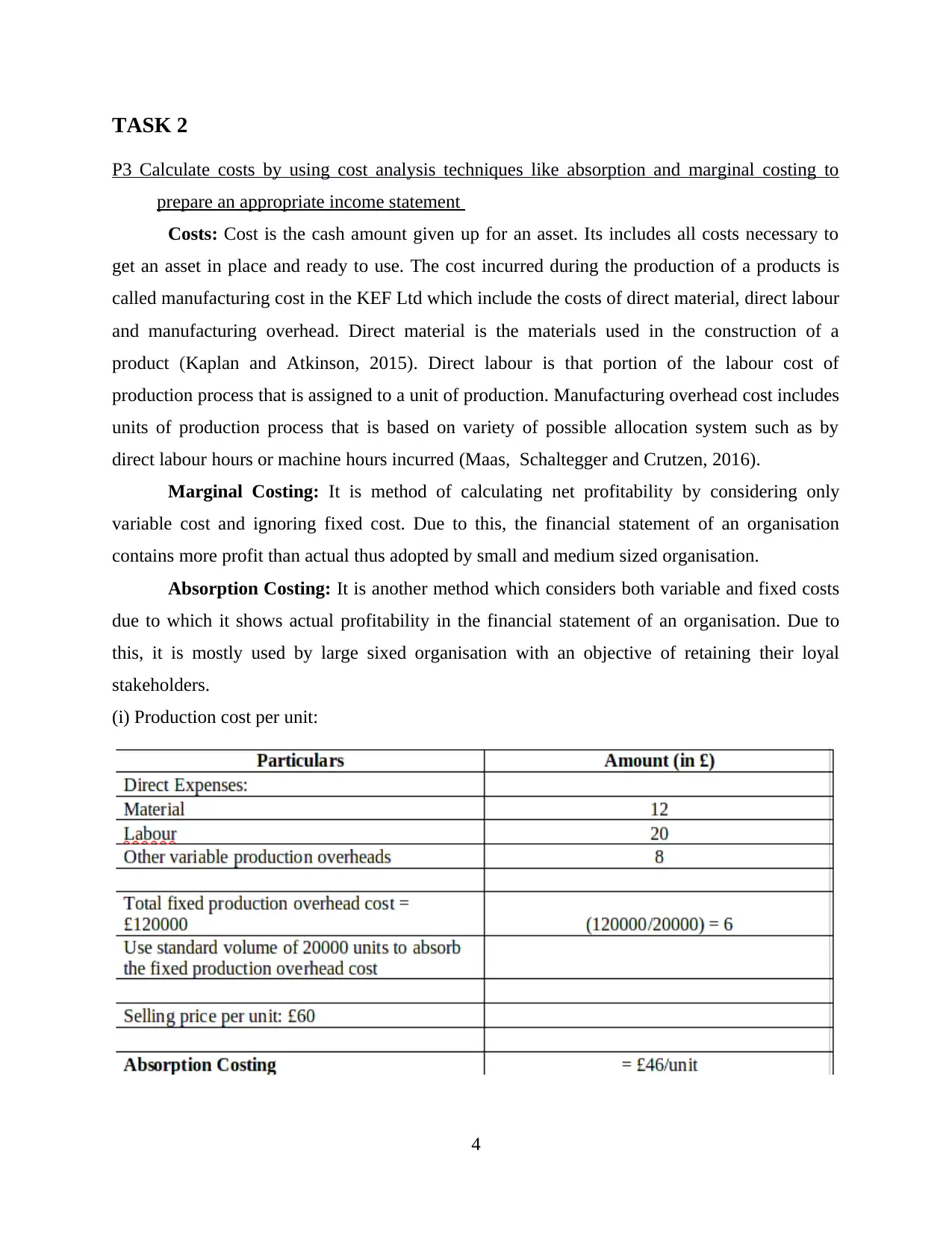
TASK 2
P3 Calculate costs by using cost analysis techniques like absorption and marginal costing to
prepare an appropriate income statement
Costs: Cost is the cash amount given up for an asset. Its includes all costs necessary to
get an asset in place and ready to use. The cost incurred during the production of a products is
called manufacturing cost in the KEF Ltd which include the costs of direct material, direct labour
and manufacturing overhead. Direct material is the materials used in the construction of a
product (Kaplan and Atkinson, 2015). Direct labour is that portion of the labour cost of
production process that is assigned to a unit of production. Manufacturing overhead cost includes
units of production process that is based on variety of possible allocation system such as by
direct labour hours or machine hours incurred (Maas, Schaltegger and Crutzen, 2016).
Marginal Costing: It is method of calculating net profitability by considering only
variable cost and ignoring fixed cost. Due to this, the financial statement of an organisation
contains more profit than actual thus adopted by small and medium sized organisation.
Absorption Costing: It is another method which considers both variable and fixed costs
due to which it shows actual profitability in the financial statement of an organisation. Due to
this, it is mostly used by large sixed organisation with an objective of retaining their loyal
stakeholders.
(i) Production cost per unit:
4
P3 Calculate costs by using cost analysis techniques like absorption and marginal costing to
prepare an appropriate income statement
Costs: Cost is the cash amount given up for an asset. Its includes all costs necessary to
get an asset in place and ready to use. The cost incurred during the production of a products is
called manufacturing cost in the KEF Ltd which include the costs of direct material, direct labour
and manufacturing overhead. Direct material is the materials used in the construction of a
product (Kaplan and Atkinson, 2015). Direct labour is that portion of the labour cost of
production process that is assigned to a unit of production. Manufacturing overhead cost includes
units of production process that is based on variety of possible allocation system such as by
direct labour hours or machine hours incurred (Maas, Schaltegger and Crutzen, 2016).
Marginal Costing: It is method of calculating net profitability by considering only
variable cost and ignoring fixed cost. Due to this, the financial statement of an organisation
contains more profit than actual thus adopted by small and medium sized organisation.
Absorption Costing: It is another method which considers both variable and fixed costs
due to which it shows actual profitability in the financial statement of an organisation. Due to
this, it is mostly used by large sixed organisation with an objective of retaining their loyal
stakeholders.
(i) Production cost per unit:
4
Paraphrase This Document
Need a fresh take? Get an instant paraphrase of this document with our AI Paraphraser
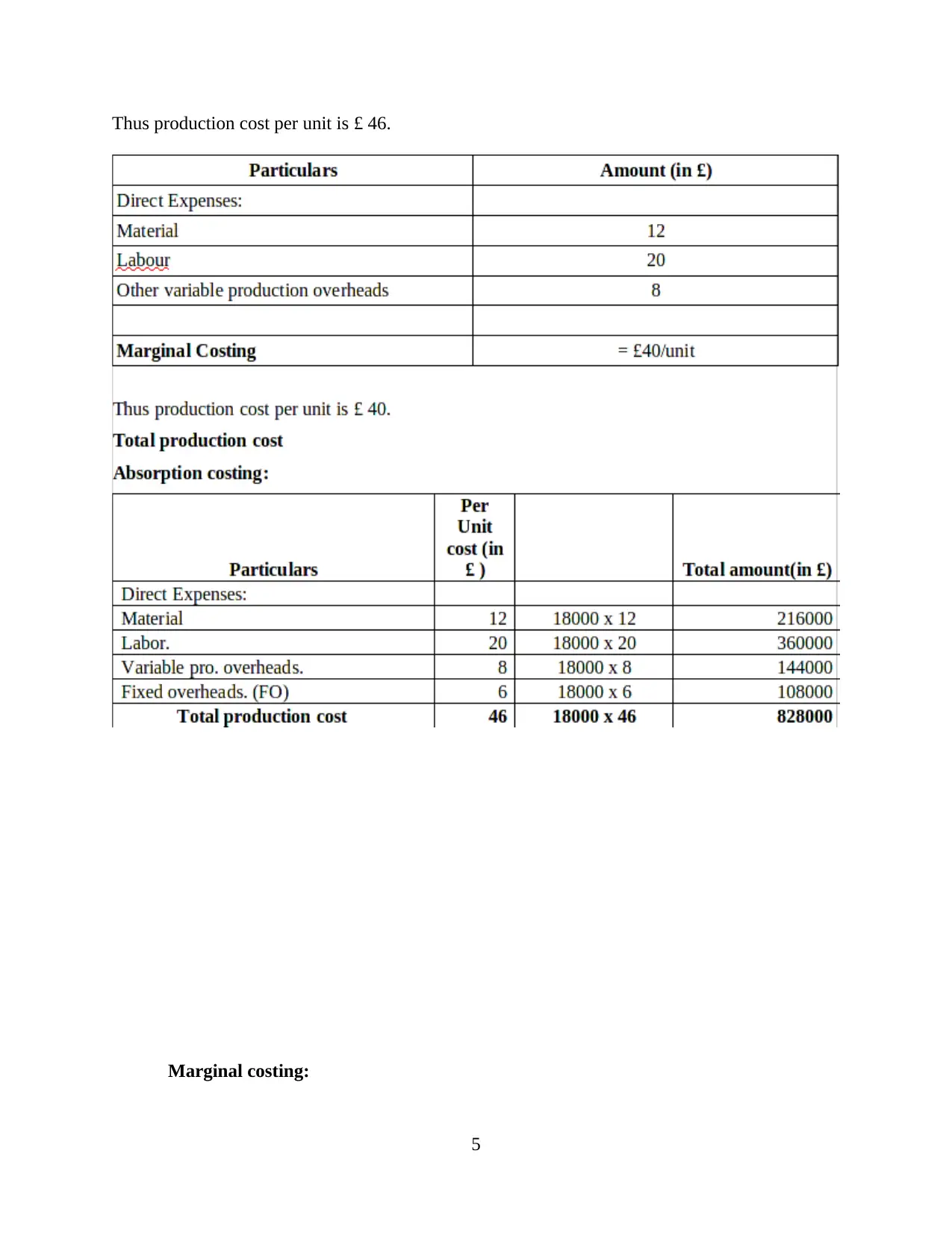
Thus production cost per unit is £ 46.
Marginal costing:
5
Marginal costing:
5
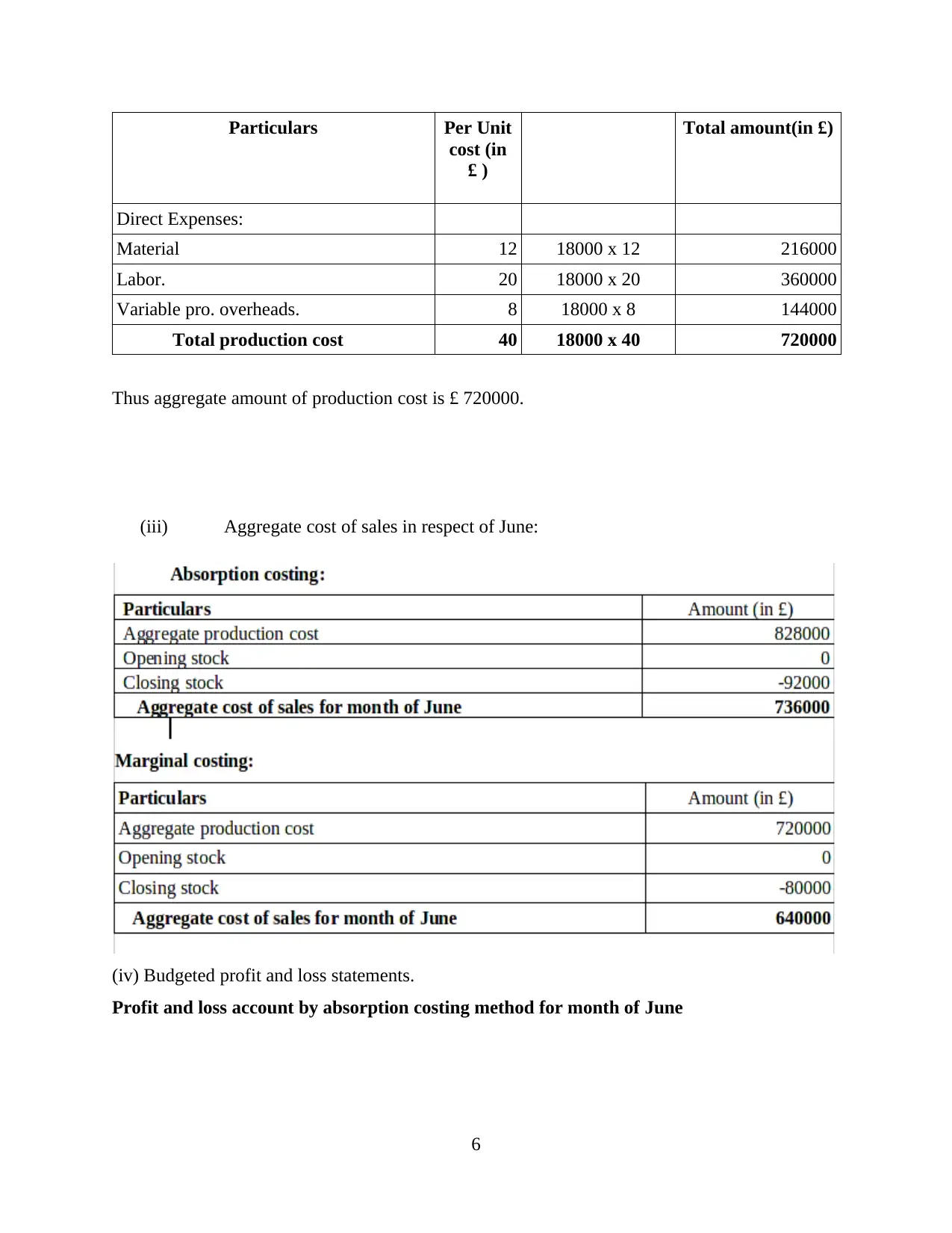
Particulars Per Unit
cost (in
£ )
Total amount(in £)
Direct Expenses:
Material 12 18000 x 12 216000
Labor. 20 18000 x 20 360000
Variable pro. overheads. 8 18000 x 8 144000
Total production cost 40 18000 x 40 720000
Thus aggregate amount of production cost is £ 720000.
(iii) Aggregate cost of sales in respect of June:
(iv) Budgeted profit and loss statements.
Profit and loss account by absorption costing method for month of June
6
cost (in
£ )
Total amount(in £)
Direct Expenses:
Material 12 18000 x 12 216000
Labor. 20 18000 x 20 360000
Variable pro. overheads. 8 18000 x 8 144000
Total production cost 40 18000 x 40 720000
Thus aggregate amount of production cost is £ 720000.
(iii) Aggregate cost of sales in respect of June:
(iv) Budgeted profit and loss statements.
Profit and loss account by absorption costing method for month of June
6
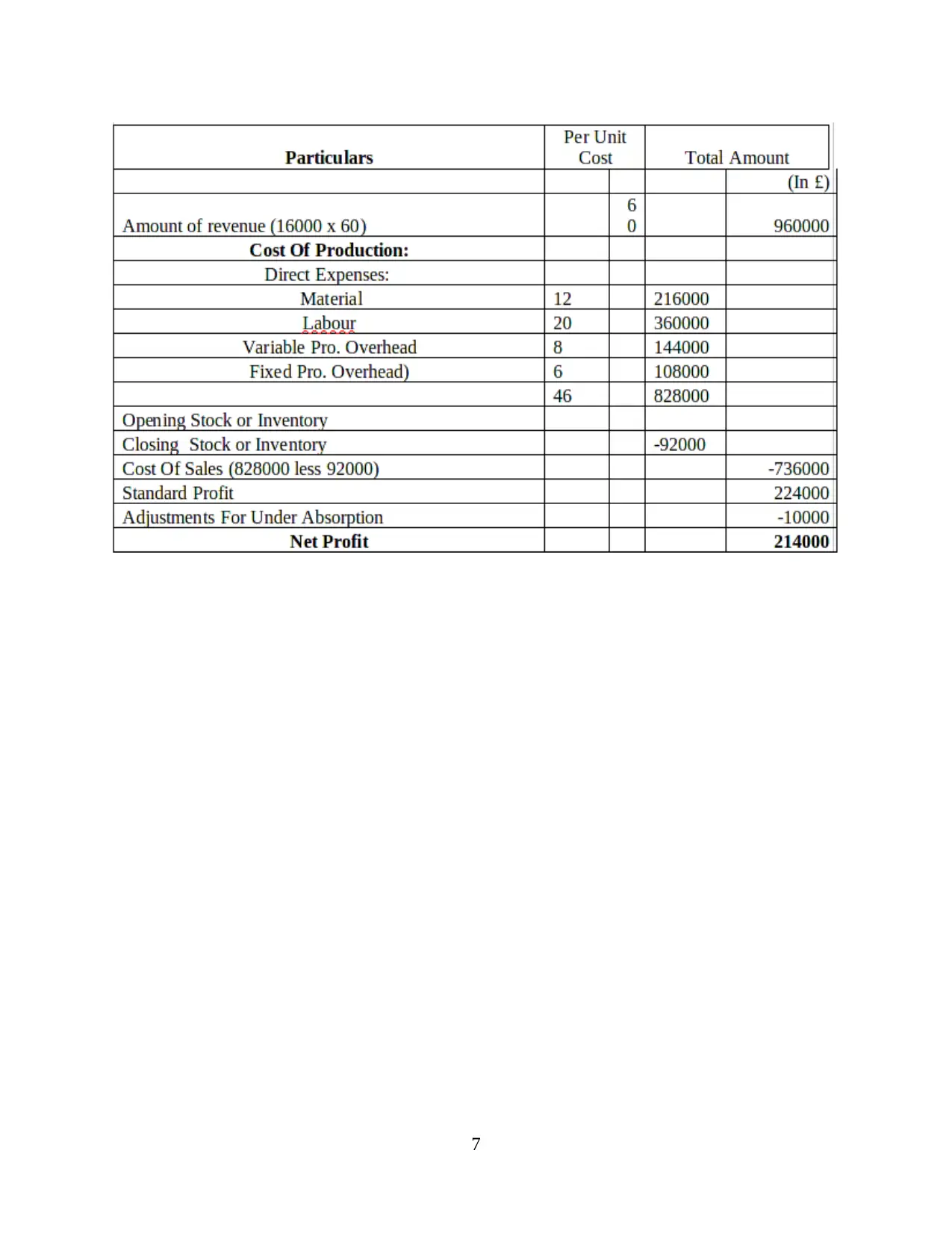
7
Secure Best Marks with AI Grader
Need help grading? Try our AI Grader for instant feedback on your assignments.
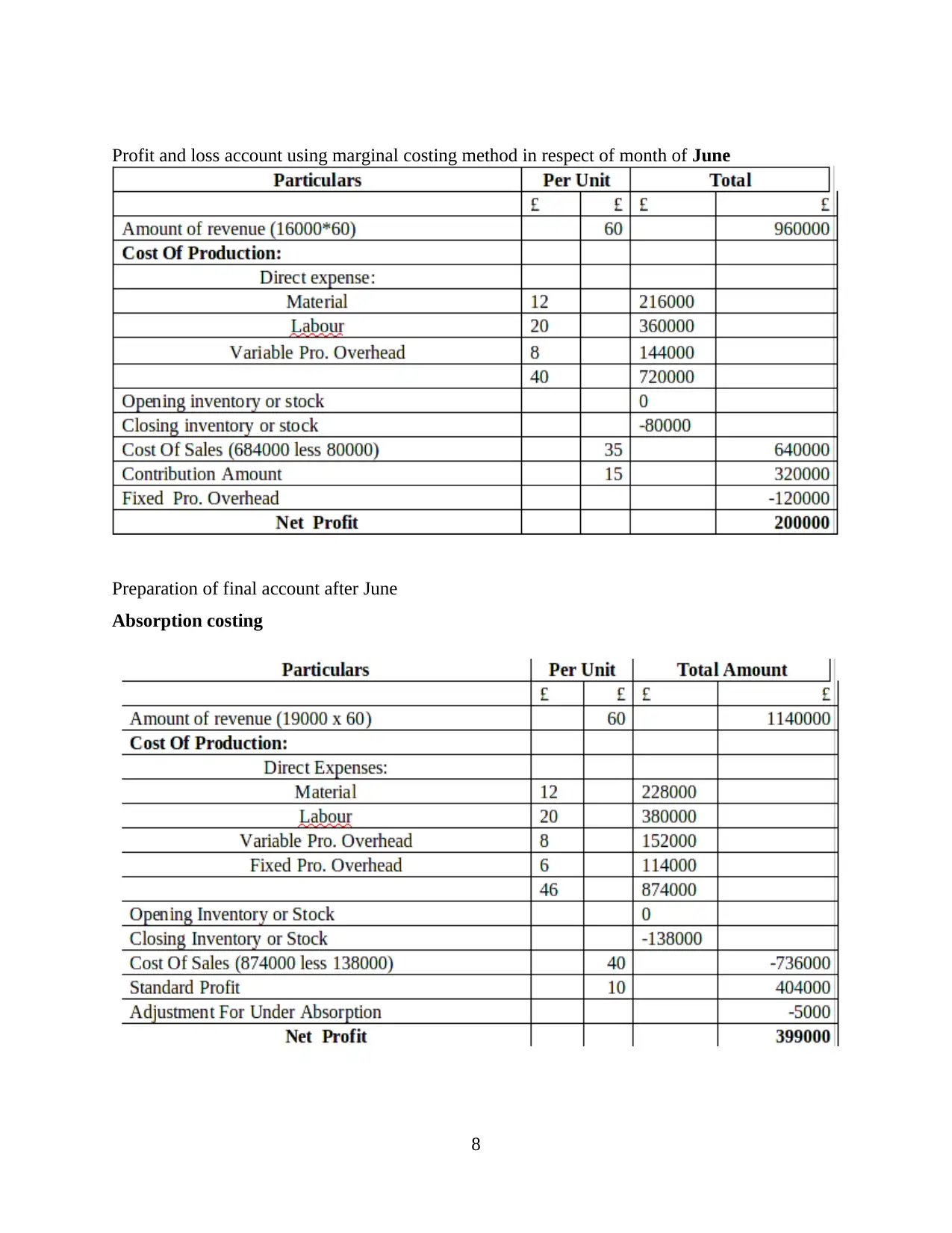
Profit and loss account using marginal costing method in respect of month of June
Preparation of final account after June
Absorption costing
8
Preparation of final account after June
Absorption costing
8
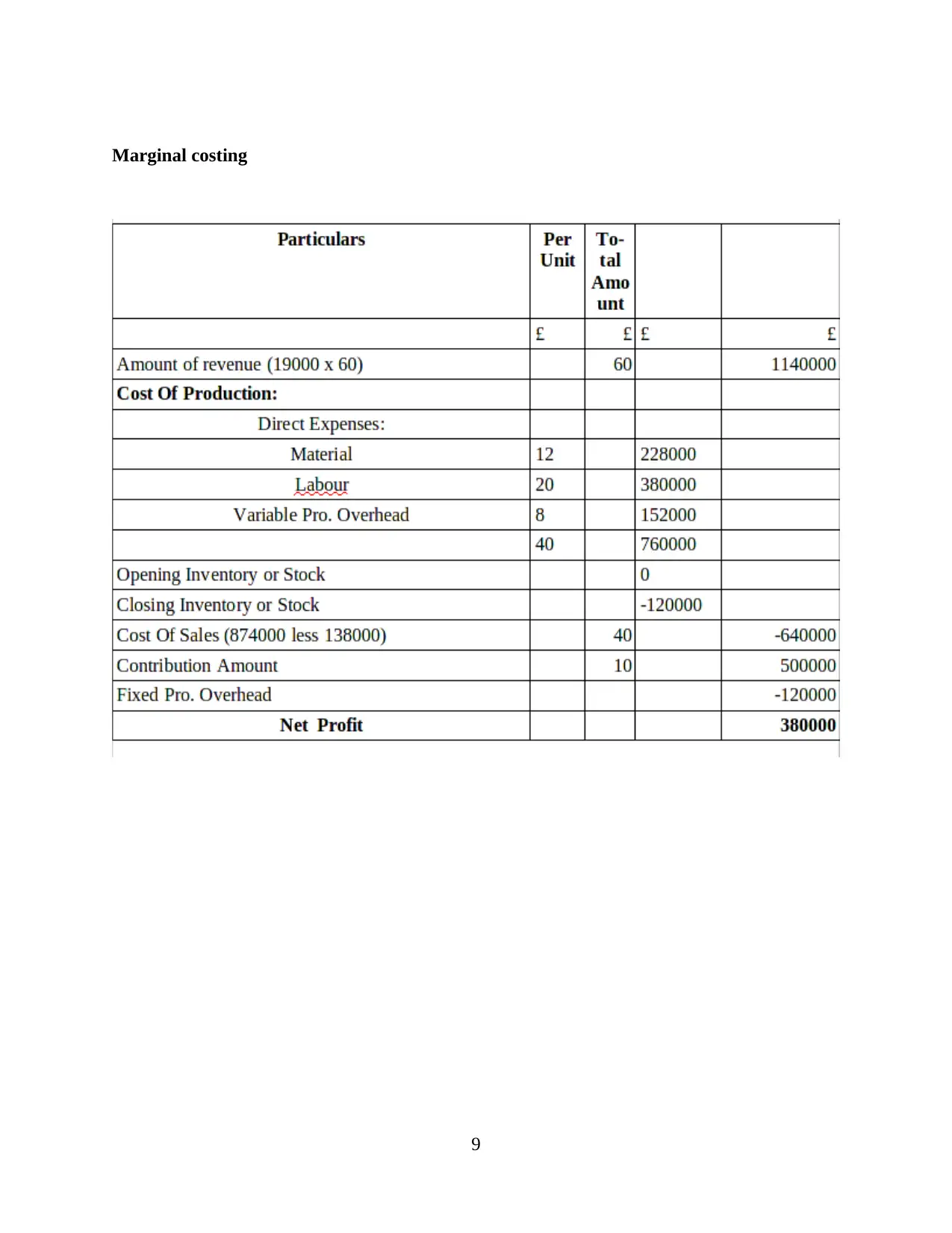
Marginal costing
9
9
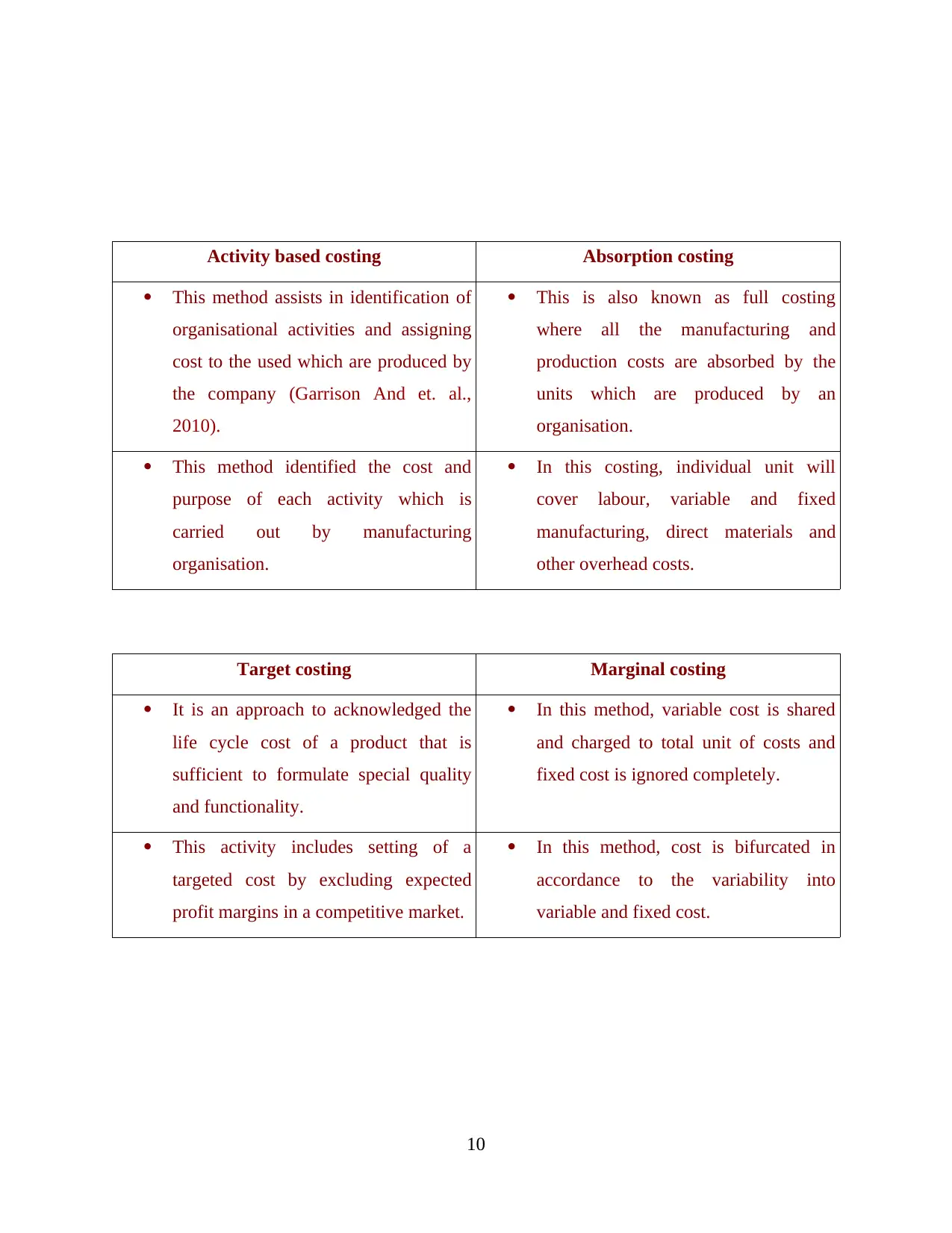
Activity based costing Absorption costing
This method assists in identification of
organisational activities and assigning
cost to the used which are produced by
the company (Garrison And et. al.,
2010).
This is also known as full costing
where all the manufacturing and
production costs are absorbed by the
units which are produced by an
organisation.
This method identified the cost and
purpose of each activity which is
carried out by manufacturing
organisation.
In this costing, individual unit will
cover labour, variable and fixed
manufacturing, direct materials and
other overhead costs.
Target costing Marginal costing
It is an approach to acknowledged the
life cycle cost of a product that is
sufficient to formulate special quality
and functionality.
In this method, variable cost is shared
and charged to total unit of costs and
fixed cost is ignored completely.
This activity includes setting of a
targeted cost by excluding expected
profit margins in a competitive market.
In this method, cost is bifurcated in
accordance to the variability into
variable and fixed cost.
10
This method assists in identification of
organisational activities and assigning
cost to the used which are produced by
the company (Garrison And et. al.,
2010).
This is also known as full costing
where all the manufacturing and
production costs are absorbed by the
units which are produced by an
organisation.
This method identified the cost and
purpose of each activity which is
carried out by manufacturing
organisation.
In this costing, individual unit will
cover labour, variable and fixed
manufacturing, direct materials and
other overhead costs.
Target costing Marginal costing
It is an approach to acknowledged the
life cycle cost of a product that is
sufficient to formulate special quality
and functionality.
In this method, variable cost is shared
and charged to total unit of costs and
fixed cost is ignored completely.
This activity includes setting of a
targeted cost by excluding expected
profit margins in a competitive market.
In this method, cost is bifurcated in
accordance to the variability into
variable and fixed cost.
10
Paraphrase This Document
Need a fresh take? Get an instant paraphrase of this document with our AI Paraphraser
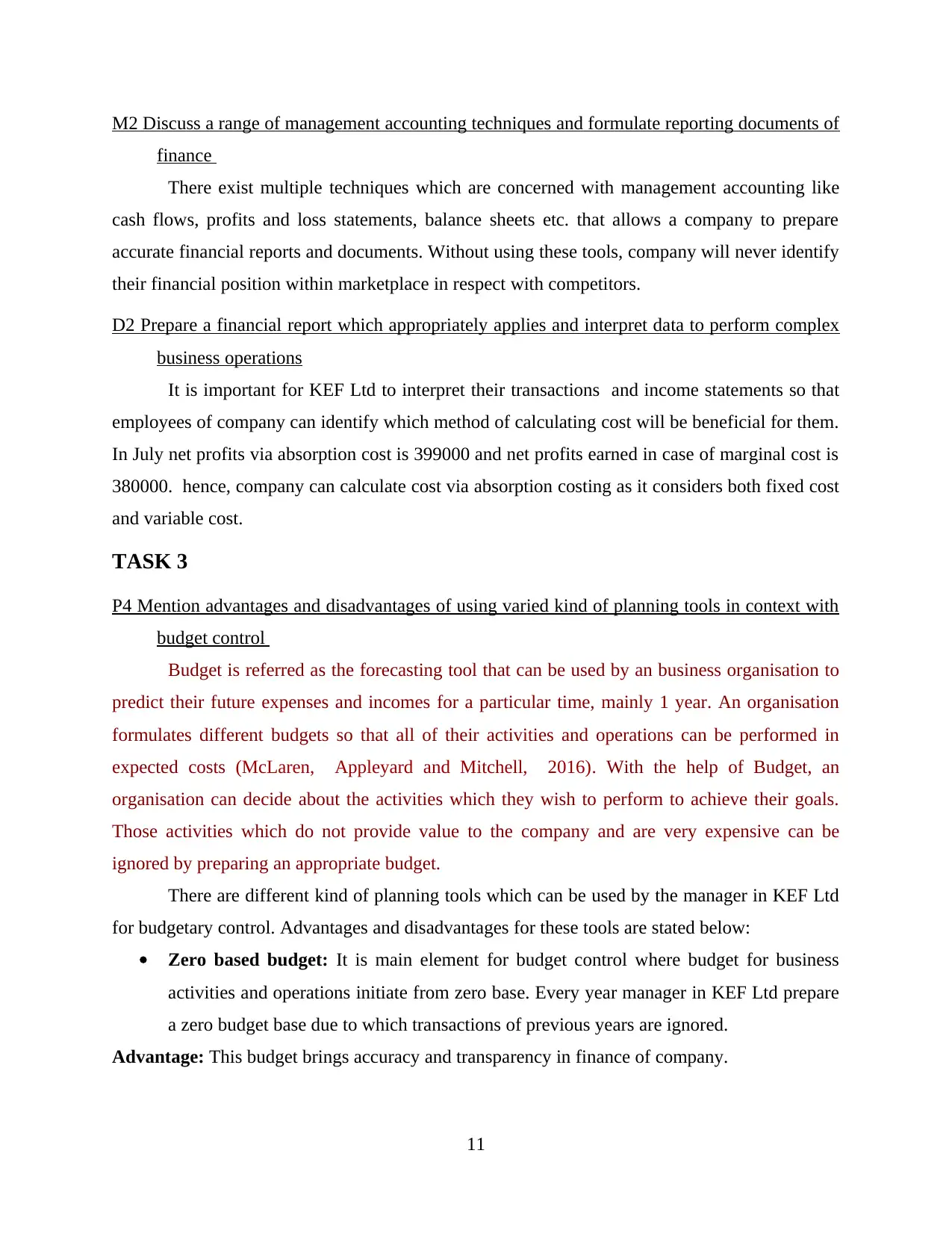
M2 Discuss a range of management accounting techniques and formulate reporting documents of
finance
There exist multiple techniques which are concerned with management accounting like
cash flows, profits and loss statements, balance sheets etc. that allows a company to prepare
accurate financial reports and documents. Without using these tools, company will never identify
their financial position within marketplace in respect with competitors.
D2 Prepare a financial report which appropriately applies and interpret data to perform complex
business operations
It is important for KEF Ltd to interpret their transactions and income statements so that
employees of company can identify which method of calculating cost will be beneficial for them.
In July net profits via absorption cost is 399000 and net profits earned in case of marginal cost is
380000. hence, company can calculate cost via absorption costing as it considers both fixed cost
and variable cost.
TASK 3
P4 Mention advantages and disadvantages of using varied kind of planning tools in context with
budget control
Budget is referred as the forecasting tool that can be used by an business organisation to
predict their future expenses and incomes for a particular time, mainly 1 year. An organisation
formulates different budgets so that all of their activities and operations can be performed in
expected costs (McLaren, Appleyard and Mitchell, 2016). With the help of Budget, an
organisation can decide about the activities which they wish to perform to achieve their goals.
Those activities which do not provide value to the company and are very expensive can be
ignored by preparing an appropriate budget.
There are different kind of planning tools which can be used by the manager in KEF Ltd
for budgetary control. Advantages and disadvantages for these tools are stated below:
Zero based budget: It is main element for budget control where budget for business
activities and operations initiate from zero base. Every year manager in KEF Ltd prepare
a zero budget base due to which transactions of previous years are ignored.
Advantage: This budget brings accuracy and transparency in finance of company.
11
finance
There exist multiple techniques which are concerned with management accounting like
cash flows, profits and loss statements, balance sheets etc. that allows a company to prepare
accurate financial reports and documents. Without using these tools, company will never identify
their financial position within marketplace in respect with competitors.
D2 Prepare a financial report which appropriately applies and interpret data to perform complex
business operations
It is important for KEF Ltd to interpret their transactions and income statements so that
employees of company can identify which method of calculating cost will be beneficial for them.
In July net profits via absorption cost is 399000 and net profits earned in case of marginal cost is
380000. hence, company can calculate cost via absorption costing as it considers both fixed cost
and variable cost.
TASK 3
P4 Mention advantages and disadvantages of using varied kind of planning tools in context with
budget control
Budget is referred as the forecasting tool that can be used by an business organisation to
predict their future expenses and incomes for a particular time, mainly 1 year. An organisation
formulates different budgets so that all of their activities and operations can be performed in
expected costs (McLaren, Appleyard and Mitchell, 2016). With the help of Budget, an
organisation can decide about the activities which they wish to perform to achieve their goals.
Those activities which do not provide value to the company and are very expensive can be
ignored by preparing an appropriate budget.
There are different kind of planning tools which can be used by the manager in KEF Ltd
for budgetary control. Advantages and disadvantages for these tools are stated below:
Zero based budget: It is main element for budget control where budget for business
activities and operations initiate from zero base. Every year manager in KEF Ltd prepare
a zero budget base due to which transactions of previous years are ignored.
Advantage: This budget brings accuracy and transparency in finance of company.
11
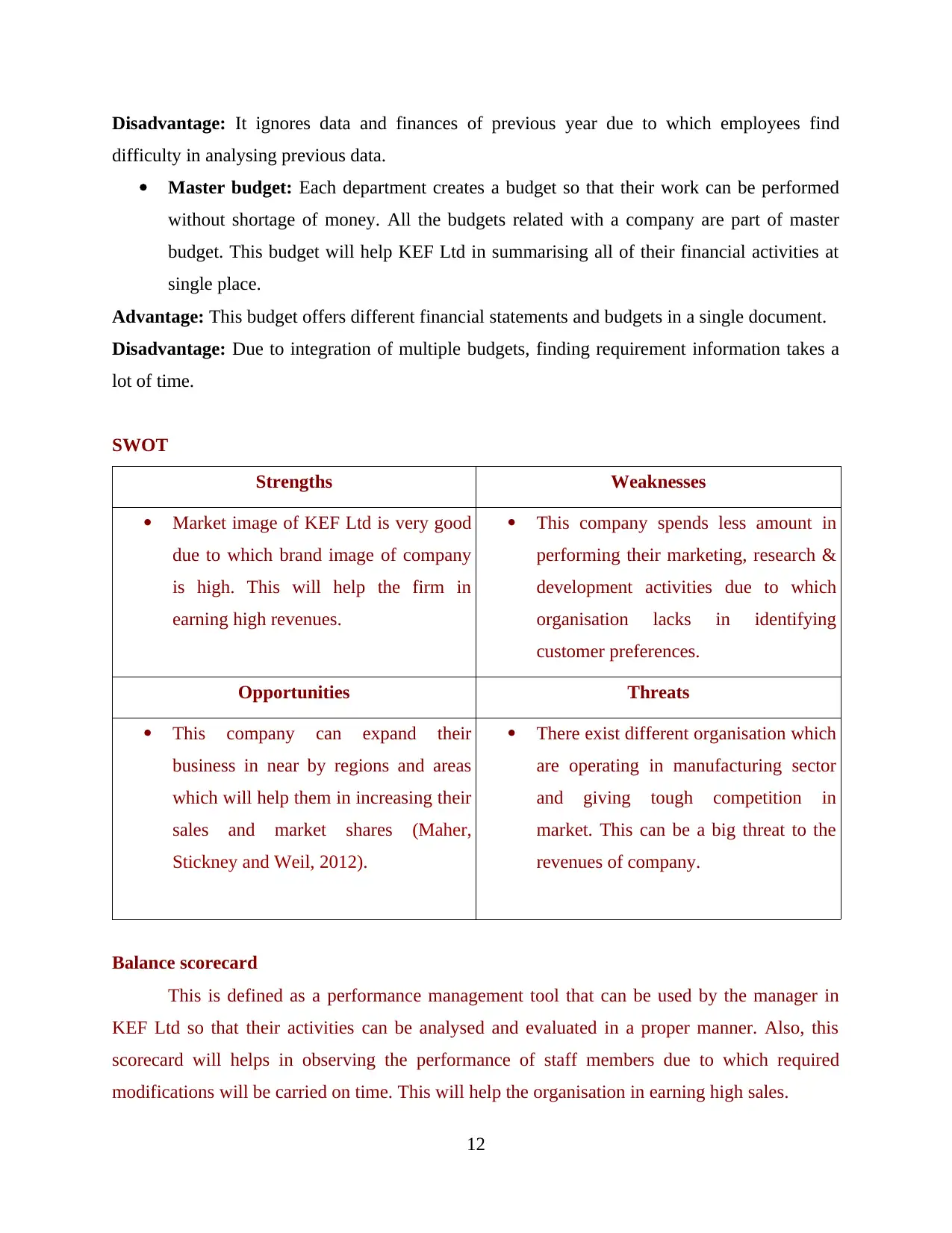
Disadvantage: It ignores data and finances of previous year due to which employees find
difficulty in analysing previous data.
Master budget: Each department creates a budget so that their work can be performed
without shortage of money. All the budgets related with a company are part of master
budget. This budget will help KEF Ltd in summarising all of their financial activities at
single place.
Advantage: This budget offers different financial statements and budgets in a single document.
Disadvantage: Due to integration of multiple budgets, finding requirement information takes a
lot of time.
SWOT
Strengths Weaknesses
Market image of KEF Ltd is very good
due to which brand image of company
is high. This will help the firm in
earning high revenues.
This company spends less amount in
performing their marketing, research &
development activities due to which
organisation lacks in identifying
customer preferences.
Opportunities Threats
This company can expand their
business in near by regions and areas
which will help them in increasing their
sales and market shares (Maher,
Stickney and Weil, 2012).
There exist different organisation which
are operating in manufacturing sector
and giving tough competition in
market. This can be a big threat to the
revenues of company.
Balance scorecard
This is defined as a performance management tool that can be used by the manager in
KEF Ltd so that their activities can be analysed and evaluated in a proper manner. Also, this
scorecard will helps in observing the performance of staff members due to which required
modifications will be carried on time. This will help the organisation in earning high sales.
12
difficulty in analysing previous data.
Master budget: Each department creates a budget so that their work can be performed
without shortage of money. All the budgets related with a company are part of master
budget. This budget will help KEF Ltd in summarising all of their financial activities at
single place.
Advantage: This budget offers different financial statements and budgets in a single document.
Disadvantage: Due to integration of multiple budgets, finding requirement information takes a
lot of time.
SWOT
Strengths Weaknesses
Market image of KEF Ltd is very good
due to which brand image of company
is high. This will help the firm in
earning high revenues.
This company spends less amount in
performing their marketing, research &
development activities due to which
organisation lacks in identifying
customer preferences.
Opportunities Threats
This company can expand their
business in near by regions and areas
which will help them in increasing their
sales and market shares (Maher,
Stickney and Weil, 2012).
There exist different organisation which
are operating in manufacturing sector
and giving tough competition in
market. This can be a big threat to the
revenues of company.
Balance scorecard
This is defined as a performance management tool that can be used by the manager in
KEF Ltd so that their activities can be analysed and evaluated in a proper manner. Also, this
scorecard will helps in observing the performance of staff members due to which required
modifications will be carried on time. This will help the organisation in earning high sales.
12
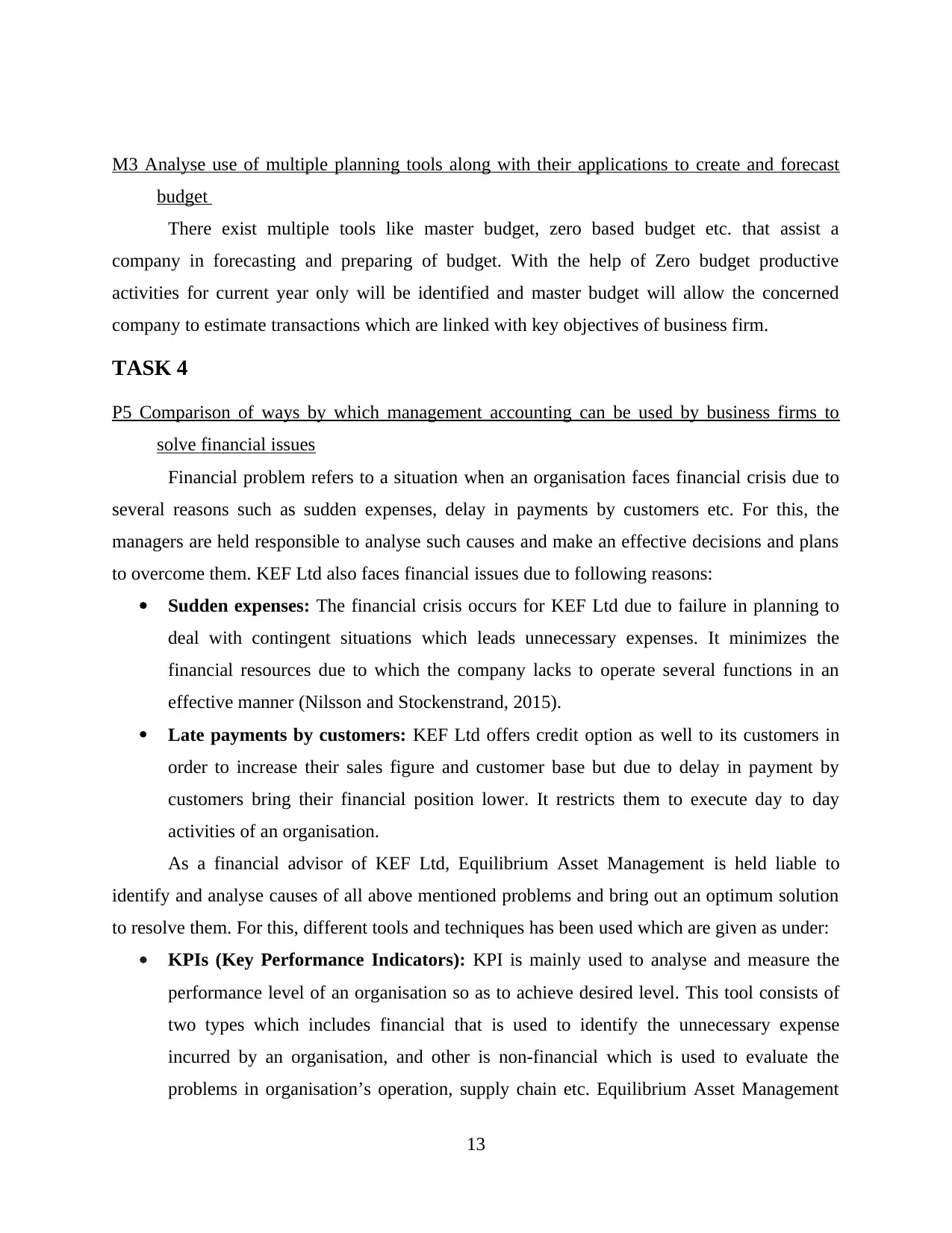
M3 Analyse use of multiple planning tools along with their applications to create and forecast
budget
There exist multiple tools like master budget, zero based budget etc. that assist a
company in forecasting and preparing of budget. With the help of Zero budget productive
activities for current year only will be identified and master budget will allow the concerned
company to estimate transactions which are linked with key objectives of business firm.
TASK 4
P5 Comparison of ways by which management accounting can be used by business firms to
solve financial issues
Financial problem refers to a situation when an organisation faces financial crisis due to
several reasons such as sudden expenses, delay in payments by customers etc. For this, the
managers are held responsible to analyse such causes and make an effective decisions and plans
to overcome them. KEF Ltd also faces financial issues due to following reasons:
Sudden expenses: The financial crisis occurs for KEF Ltd due to failure in planning to
deal with contingent situations which leads unnecessary expenses. It minimizes the
financial resources due to which the company lacks to operate several functions in an
effective manner (Nilsson and Stockenstrand, 2015).
Late payments by customers: KEF Ltd offers credit option as well to its customers in
order to increase their sales figure and customer base but due to delay in payment by
customers bring their financial position lower. It restricts them to execute day to day
activities of an organisation.
As a financial advisor of KEF Ltd, Equilibrium Asset Management is held liable to
identify and analyse causes of all above mentioned problems and bring out an optimum solution
to resolve them. For this, different tools and techniques has been used which are given as under:
KPIs (Key Performance Indicators): KPI is mainly used to analyse and measure the
performance level of an organisation so as to achieve desired level. This tool consists of
two types which includes financial that is used to identify the unnecessary expense
incurred by an organisation, and other is non-financial which is used to evaluate the
problems in organisation’s operation, supply chain etc. Equilibrium Asset Management
13
budget
There exist multiple tools like master budget, zero based budget etc. that assist a
company in forecasting and preparing of budget. With the help of Zero budget productive
activities for current year only will be identified and master budget will allow the concerned
company to estimate transactions which are linked with key objectives of business firm.
TASK 4
P5 Comparison of ways by which management accounting can be used by business firms to
solve financial issues
Financial problem refers to a situation when an organisation faces financial crisis due to
several reasons such as sudden expenses, delay in payments by customers etc. For this, the
managers are held responsible to analyse such causes and make an effective decisions and plans
to overcome them. KEF Ltd also faces financial issues due to following reasons:
Sudden expenses: The financial crisis occurs for KEF Ltd due to failure in planning to
deal with contingent situations which leads unnecessary expenses. It minimizes the
financial resources due to which the company lacks to operate several functions in an
effective manner (Nilsson and Stockenstrand, 2015).
Late payments by customers: KEF Ltd offers credit option as well to its customers in
order to increase their sales figure and customer base but due to delay in payment by
customers bring their financial position lower. It restricts them to execute day to day
activities of an organisation.
As a financial advisor of KEF Ltd, Equilibrium Asset Management is held liable to
identify and analyse causes of all above mentioned problems and bring out an optimum solution
to resolve them. For this, different tools and techniques has been used which are given as under:
KPIs (Key Performance Indicators): KPI is mainly used to analyse and measure the
performance level of an organisation so as to achieve desired level. This tool consists of
two types which includes financial that is used to identify the unnecessary expense
incurred by an organisation, and other is non-financial which is used to evaluate the
problems in organisation’s operation, supply chain etc. Equilibrium Asset Management
13
Secure Best Marks with AI Grader
Need help grading? Try our AI Grader for instant feedback on your assignments.
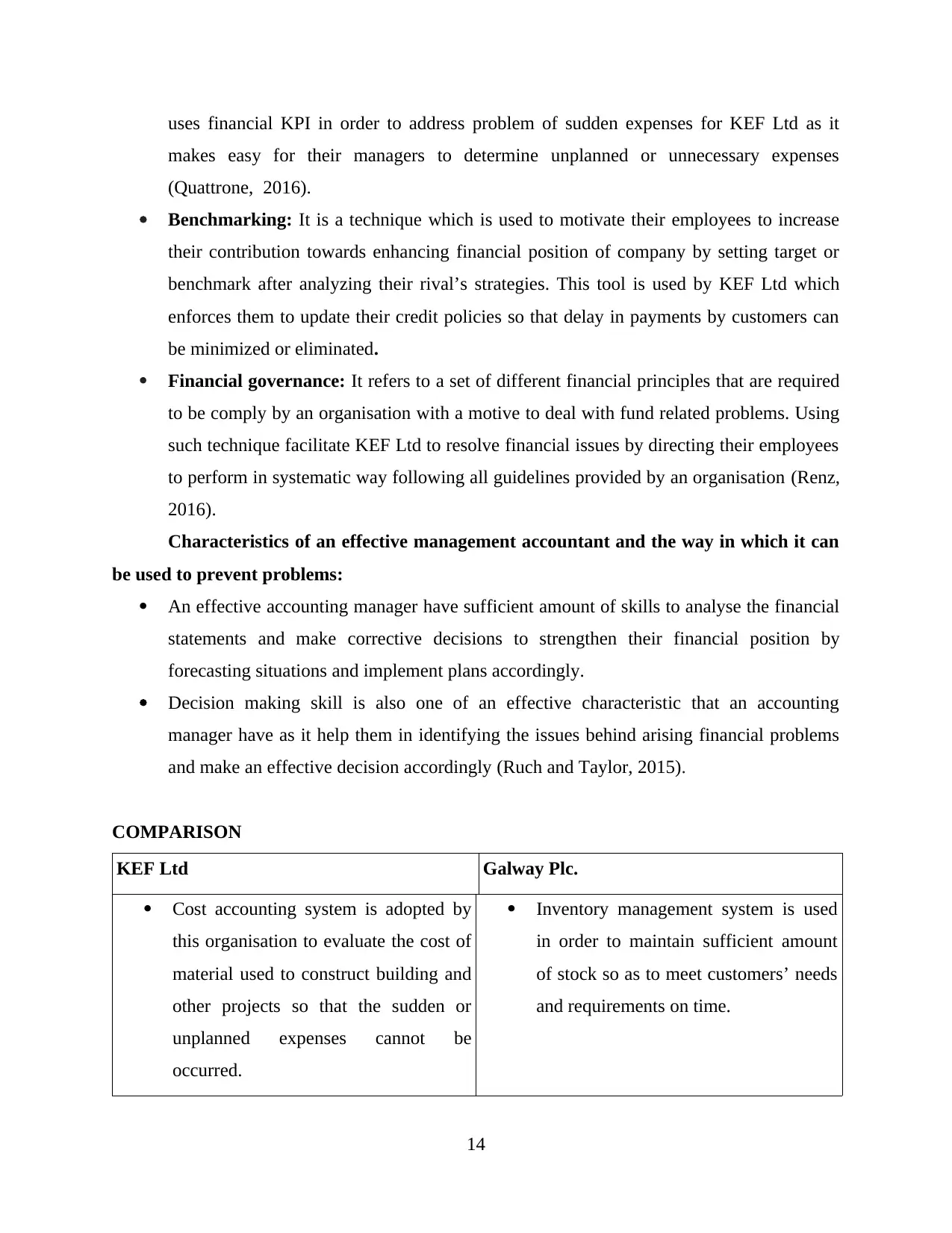
uses financial KPI in order to address problem of sudden expenses for KEF Ltd as it
makes easy for their managers to determine unplanned or unnecessary expenses
(Quattrone, 2016).
Benchmarking: It is a technique which is used to motivate their employees to increase
their contribution towards enhancing financial position of company by setting target or
benchmark after analyzing their rival’s strategies. This tool is used by KEF Ltd which
enforces them to update their credit policies so that delay in payments by customers can
be minimized or eliminated.
Financial governance: It refers to a set of different financial principles that are required
to be comply by an organisation with a motive to deal with fund related problems. Using
such technique facilitate KEF Ltd to resolve financial issues by directing their employees
to perform in systematic way following all guidelines provided by an organisation (Renz,
2016).
Characteristics of an effective management accountant and the way in which it can
be used to prevent problems:
An effective accounting manager have sufficient amount of skills to analyse the financial
statements and make corrective decisions to strengthen their financial position by
forecasting situations and implement plans accordingly.
Decision making skill is also one of an effective characteristic that an accounting
manager have as it help them in identifying the issues behind arising financial problems
and make an effective decision accordingly (Ruch and Taylor, 2015).
COMPARISON
KEF Ltd Galway Plc.
Cost accounting system is adopted by
this organisation to evaluate the cost of
material used to construct building and
other projects so that the sudden or
unplanned expenses cannot be
occurred.
Inventory management system is used
in order to maintain sufficient amount
of stock so as to meet customers’ needs
and requirements on time.
14
makes easy for their managers to determine unplanned or unnecessary expenses
(Quattrone, 2016).
Benchmarking: It is a technique which is used to motivate their employees to increase
their contribution towards enhancing financial position of company by setting target or
benchmark after analyzing their rival’s strategies. This tool is used by KEF Ltd which
enforces them to update their credit policies so that delay in payments by customers can
be minimized or eliminated.
Financial governance: It refers to a set of different financial principles that are required
to be comply by an organisation with a motive to deal with fund related problems. Using
such technique facilitate KEF Ltd to resolve financial issues by directing their employees
to perform in systematic way following all guidelines provided by an organisation (Renz,
2016).
Characteristics of an effective management accountant and the way in which it can
be used to prevent problems:
An effective accounting manager have sufficient amount of skills to analyse the financial
statements and make corrective decisions to strengthen their financial position by
forecasting situations and implement plans accordingly.
Decision making skill is also one of an effective characteristic that an accounting
manager have as it help them in identifying the issues behind arising financial problems
and make an effective decision accordingly (Ruch and Taylor, 2015).
COMPARISON
KEF Ltd Galway Plc.
Cost accounting system is adopted by
this organisation to evaluate the cost of
material used to construct building and
other projects so that the sudden or
unplanned expenses cannot be
occurred.
Inventory management system is used
in order to maintain sufficient amount
of stock so as to meet customers’ needs
and requirements on time.
14
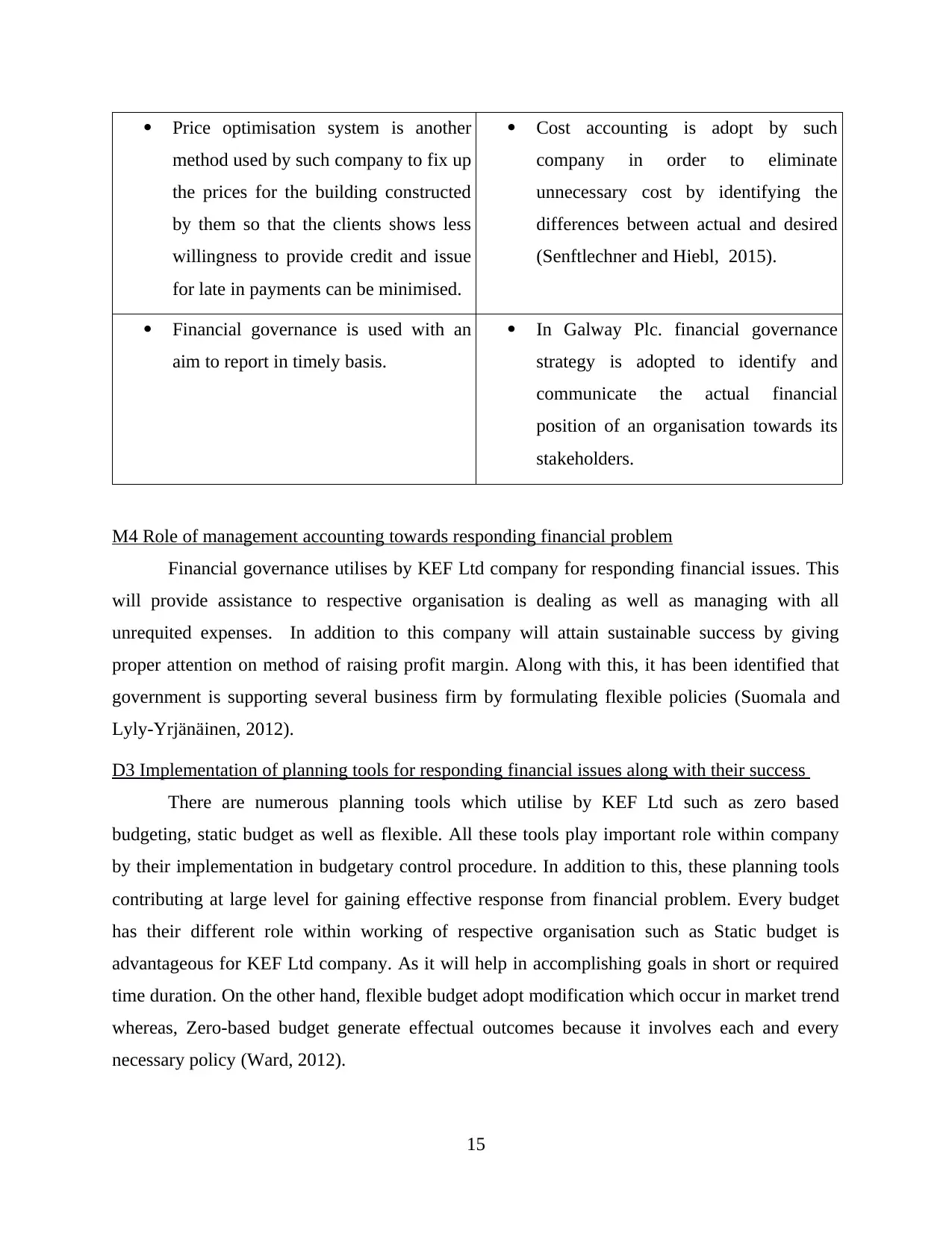
Price optimisation system is another
method used by such company to fix up
the prices for the building constructed
by them so that the clients shows less
willingness to provide credit and issue
for late in payments can be minimised.
Cost accounting is adopt by such
company in order to eliminate
unnecessary cost by identifying the
differences between actual and desired
(Senftlechner and Hiebl, 2015).
Financial governance is used with an
aim to report in timely basis.
In Galway Plc. financial governance
strategy is adopted to identify and
communicate the actual financial
position of an organisation towards its
stakeholders.
M4 Role of management accounting towards responding financial problem
Financial governance utilises by KEF Ltd company for responding financial issues. This
will provide assistance to respective organisation is dealing as well as managing with all
unrequited expenses. In addition to this company will attain sustainable success by giving
proper attention on method of raising profit margin. Along with this, it has been identified that
government is supporting several business firm by formulating flexible policies (Suomala and
Lyly-Yrjänäinen, 2012).
D3 Implementation of planning tools for responding financial issues along with their success
There are numerous planning tools which utilise by KEF Ltd such as zero based
budgeting, static budget as well as flexible. All these tools play important role within company
by their implementation in budgetary control procedure. In addition to this, these planning tools
contributing at large level for gaining effective response from financial problem. Every budget
has their different role within working of respective organisation such as Static budget is
advantageous for KEF Ltd company. As it will help in accomplishing goals in short or required
time duration. On the other hand, flexible budget adopt modification which occur in market trend
whereas, Zero-based budget generate effectual outcomes because it involves each and every
necessary policy (Ward, 2012).
15
method used by such company to fix up
the prices for the building constructed
by them so that the clients shows less
willingness to provide credit and issue
for late in payments can be minimised.
Cost accounting is adopt by such
company in order to eliminate
unnecessary cost by identifying the
differences between actual and desired
(Senftlechner and Hiebl, 2015).
Financial governance is used with an
aim to report in timely basis.
In Galway Plc. financial governance
strategy is adopted to identify and
communicate the actual financial
position of an organisation towards its
stakeholders.
M4 Role of management accounting towards responding financial problem
Financial governance utilises by KEF Ltd company for responding financial issues. This
will provide assistance to respective organisation is dealing as well as managing with all
unrequited expenses. In addition to this company will attain sustainable success by giving
proper attention on method of raising profit margin. Along with this, it has been identified that
government is supporting several business firm by formulating flexible policies (Suomala and
Lyly-Yrjänäinen, 2012).
D3 Implementation of planning tools for responding financial issues along with their success
There are numerous planning tools which utilise by KEF Ltd such as zero based
budgeting, static budget as well as flexible. All these tools play important role within company
by their implementation in budgetary control procedure. In addition to this, these planning tools
contributing at large level for gaining effective response from financial problem. Every budget
has their different role within working of respective organisation such as Static budget is
advantageous for KEF Ltd company. As it will help in accomplishing goals in short or required
time duration. On the other hand, flexible budget adopt modification which occur in market trend
whereas, Zero-based budget generate effectual outcomes because it involves each and every
necessary policy (Ward, 2012).
15
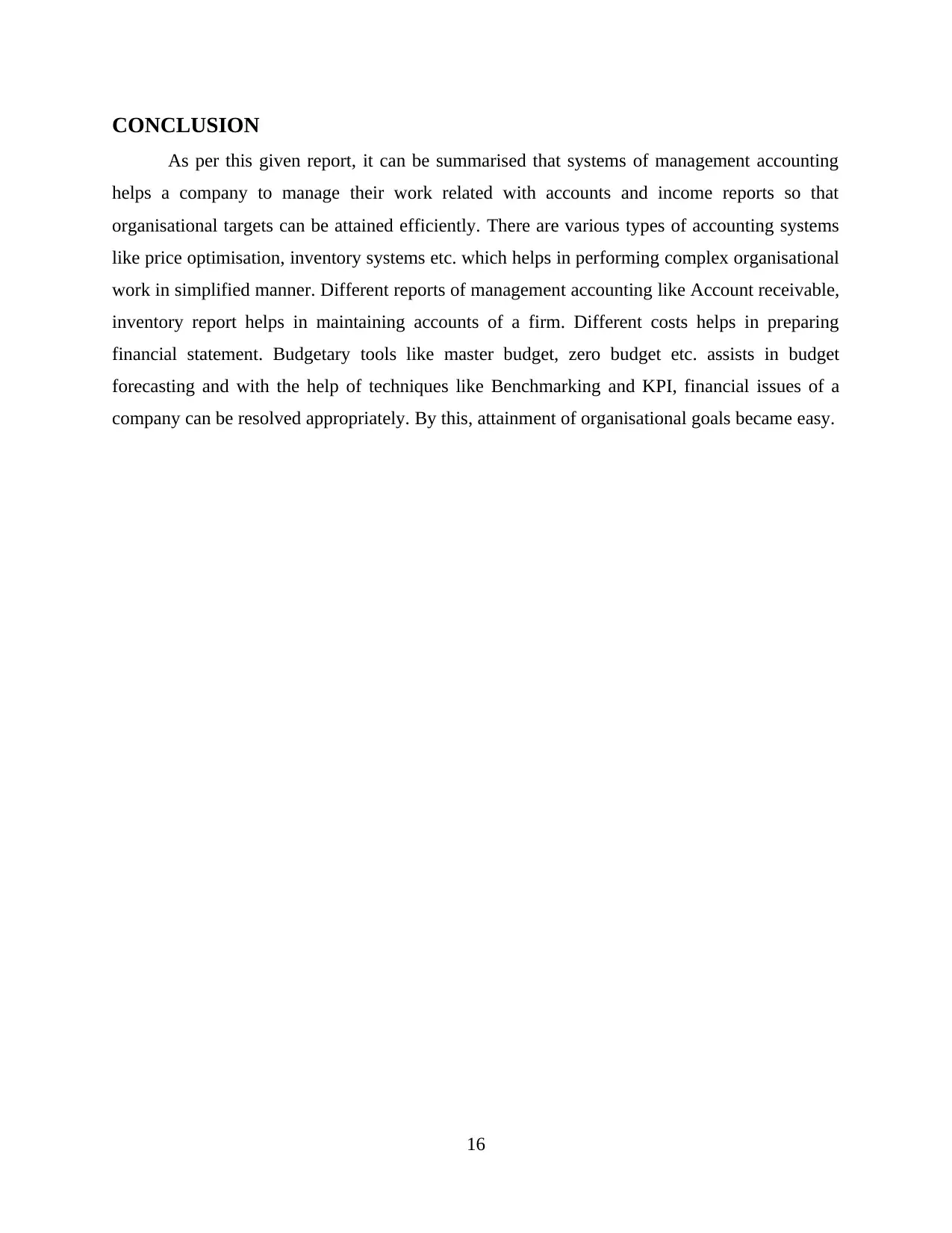
CONCLUSION
As per this given report, it can be summarised that systems of management accounting
helps a company to manage their work related with accounts and income reports so that
organisational targets can be attained efficiently. There are various types of accounting systems
like price optimisation, inventory systems etc. which helps in performing complex organisational
work in simplified manner. Different reports of management accounting like Account receivable,
inventory report helps in maintaining accounts of a firm. Different costs helps in preparing
financial statement. Budgetary tools like master budget, zero budget etc. assists in budget
forecasting and with the help of techniques like Benchmarking and KPI, financial issues of a
company can be resolved appropriately. By this, attainment of organisational goals became easy.
16
As per this given report, it can be summarised that systems of management accounting
helps a company to manage their work related with accounts and income reports so that
organisational targets can be attained efficiently. There are various types of accounting systems
like price optimisation, inventory systems etc. which helps in performing complex organisational
work in simplified manner. Different reports of management accounting like Account receivable,
inventory report helps in maintaining accounts of a firm. Different costs helps in preparing
financial statement. Budgetary tools like master budget, zero budget etc. assists in budget
forecasting and with the help of techniques like Benchmarking and KPI, financial issues of a
company can be resolved appropriately. By this, attainment of organisational goals became easy.
16
Paraphrase This Document
Need a fresh take? Get an instant paraphrase of this document with our AI Paraphraser
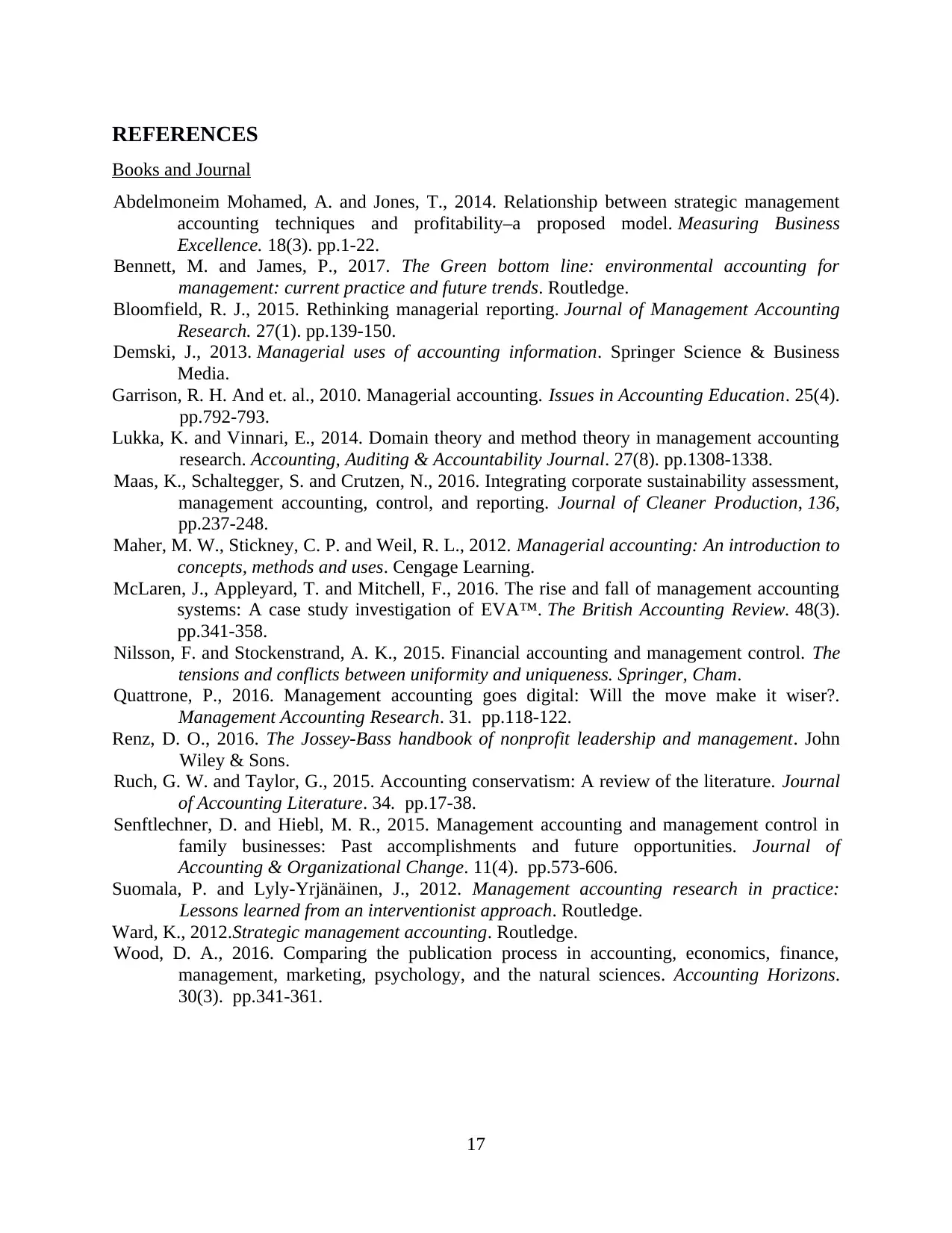
REFERENCES
Books and Journal
Abdelmoneim Mohamed, A. and Jones, T., 2014. Relationship between strategic management
accounting techniques and profitability–a proposed model. Measuring Business
Excellence. 18(3). pp.1-22.
Bennett, M. and James, P., 2017. The Green bottom line: environmental accounting for
management: current practice and future trends. Routledge.
Bloomfield, R. J., 2015. Rethinking managerial reporting. Journal of Management Accounting
Research. 27(1). pp.139-150.
Demski, J., 2013. Managerial uses of accounting information. Springer Science & Business
Media.
Garrison, R. H. And et. al., 2010. Managerial accounting. Issues in Accounting Education. 25(4).
pp.792-793.
Lukka, K. and Vinnari, E., 2014. Domain theory and method theory in management accounting
research. Accounting, Auditing & Accountability Journal. 27(8). pp.1308-1338.
Maas, K., Schaltegger, S. and Crutzen, N., 2016. Integrating corporate sustainability assessment,
management accounting, control, and reporting. Journal of Cleaner Production, 136,
pp.237-248.
Maher, M. W., Stickney, C. P. and Weil, R. L., 2012. Managerial accounting: An introduction to
concepts, methods and uses. Cengage Learning.
McLaren, J., Appleyard, T. and Mitchell, F., 2016. The rise and fall of management accounting
systems: A case study investigation of EVA™. The British Accounting Review. 48(3).
pp.341-358.
Nilsson, F. and Stockenstrand, A. K., 2015. Financial accounting and management control. The
tensions and conflicts between uniformity and uniqueness. Springer, Cham.
Quattrone, P., 2016. Management accounting goes digital: Will the move make it wiser?.
Management Accounting Research. 31. pp.118-122.
Renz, D. O., 2016. The Jossey-Bass handbook of nonprofit leadership and management. John
Wiley & Sons.
Ruch, G. W. and Taylor, G., 2015. Accounting conservatism: A review of the literature. Journal
of Accounting Literature. 34. pp.17-38.
Senftlechner, D. and Hiebl, M. R., 2015. Management accounting and management control in
family businesses: Past accomplishments and future opportunities. Journal of
Accounting & Organizational Change. 11(4). pp.573-606.
Suomala, P. and Lyly-Yrjänäinen, J., 2012. Management accounting research in practice:
Lessons learned from an interventionist approach. Routledge.
Ward, K., 2012.Strategic management accounting. Routledge.
Wood, D. A., 2016. Comparing the publication process in accounting, economics, finance,
management, marketing, psychology, and the natural sciences. Accounting Horizons.
30(3). pp.341-361.
17
Books and Journal
Abdelmoneim Mohamed, A. and Jones, T., 2014. Relationship between strategic management
accounting techniques and profitability–a proposed model. Measuring Business
Excellence. 18(3). pp.1-22.
Bennett, M. and James, P., 2017. The Green bottom line: environmental accounting for
management: current practice and future trends. Routledge.
Bloomfield, R. J., 2015. Rethinking managerial reporting. Journal of Management Accounting
Research. 27(1). pp.139-150.
Demski, J., 2013. Managerial uses of accounting information. Springer Science & Business
Media.
Garrison, R. H. And et. al., 2010. Managerial accounting. Issues in Accounting Education. 25(4).
pp.792-793.
Lukka, K. and Vinnari, E., 2014. Domain theory and method theory in management accounting
research. Accounting, Auditing & Accountability Journal. 27(8). pp.1308-1338.
Maas, K., Schaltegger, S. and Crutzen, N., 2016. Integrating corporate sustainability assessment,
management accounting, control, and reporting. Journal of Cleaner Production, 136,
pp.237-248.
Maher, M. W., Stickney, C. P. and Weil, R. L., 2012. Managerial accounting: An introduction to
concepts, methods and uses. Cengage Learning.
McLaren, J., Appleyard, T. and Mitchell, F., 2016. The rise and fall of management accounting
systems: A case study investigation of EVA™. The British Accounting Review. 48(3).
pp.341-358.
Nilsson, F. and Stockenstrand, A. K., 2015. Financial accounting and management control. The
tensions and conflicts between uniformity and uniqueness. Springer, Cham.
Quattrone, P., 2016. Management accounting goes digital: Will the move make it wiser?.
Management Accounting Research. 31. pp.118-122.
Renz, D. O., 2016. The Jossey-Bass handbook of nonprofit leadership and management. John
Wiley & Sons.
Ruch, G. W. and Taylor, G., 2015. Accounting conservatism: A review of the literature. Journal
of Accounting Literature. 34. pp.17-38.
Senftlechner, D. and Hiebl, M. R., 2015. Management accounting and management control in
family businesses: Past accomplishments and future opportunities. Journal of
Accounting & Organizational Change. 11(4). pp.573-606.
Suomala, P. and Lyly-Yrjänäinen, J., 2012. Management accounting research in practice:
Lessons learned from an interventionist approach. Routledge.
Ward, K., 2012.Strategic management accounting. Routledge.
Wood, D. A., 2016. Comparing the publication process in accounting, economics, finance,
management, marketing, psychology, and the natural sciences. Accounting Horizons.
30(3). pp.341-361.
17
1 out of 20
Related Documents
Your All-in-One AI-Powered Toolkit for Academic Success.
+13062052269
info@desklib.com
Available 24*7 on WhatsApp / Email
![[object Object]](/_next/static/media/star-bottom.7253800d.svg)
Unlock your academic potential
© 2024 | Zucol Services PVT LTD | All rights reserved.





